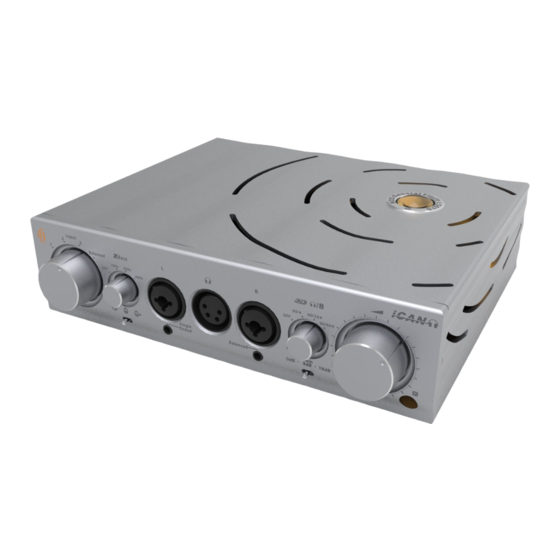
Table of Contents
Advertisement
Quick Links
Advertisement
Table of Contents

Subscribe to Our Youtube Channel
Summary of Contents for ifi Pro series iCAN
- Page 1 Pro iCAN User Manual...
- Page 2 Thank you for purchasing this Pro series iCAN. The Pro iCAN is both : (i) a Professional Headphone Ampli er; (ii) a fully- edged, High-end Preampli er. WARNING: The Pro iCAN is VERY POWERFUL and can o er very large amounts of sub-bass boost. As a start- ®...
-
Page 3: Table Of Contents
iCAN 10 11 Holographic for Headphones® / LED Logo (illuminated) Holographic for Loudspeakers® Systems Power Switch NOS GE5670 Tubes Input Selector Gain Selection ® Bass Correction System Volume Control P.10 Operation Modes (Solid-State/Tube/Tube+) IR Remote Control P.10 Headphone Output Sockets... - Page 4 Balanced Input Quad-Damped Isolation Base Mount P.10 P.11 Unbalanced Inputs 1-3 DC Loop-Out P.10 P.11 Balanced Line Output Connector for iFi Electrostatic Add-On Module P.10 P.11 Unbalanced Line Outputs P.10 DC Power Supply Input P.11...
-
Page 5: Led Logo (Illuminated)
LED Logo Warming-up: Orange ( ashing) Tube/Tube+ mode: Orange Solid-State mode: White Protection: Red Tip: See Section 5 for details of the di erent operation modes. Power Switch ON/OFF. Note: When switched on, the Pro iCAN will go through a warm-up sequence of 45 seconds before it is operational. Input Selector Input 1-3: RCA, single-ended. -
Page 6: Operation Modes (Solid-State/Tube/Tube+)
® OFF: is disabled (this allows the ‘direct’ sound to be enjoyed). 10Hz: for headphones/loudspeakers missing only the very lowest bass (below 40Hz). 20Hz: for headphones/loudspeakers missing some bass (below 80Hz). 40Hz: for headphones/loudspeakers missing substantial bass including some mid-bass (below 160Hz). ®... -
Page 7: Headphone Output Sockets
6.3mm TRS x 2 (iFi SEC balanced system) Note: The iFi SEC (Single-Ended Compatible) balanced connection uses one 6.3mm Jack for L-/R- (left jack) and the other for L+/R+ (right jack) with both sleeves being Ground (GND). This makes it directly compatible with standard non-balanced headphones. -
Page 8: Holographic For Headphones® / Holographic For Loudspeakers® Systems
6d. 3.5mm (Balanced, TRRS standard) 3.5mm TRRS (with built-in iEMatch® – output matched to high-sensitivity headphones). Holographic for Headphones® / Holographic for Loudspeakers® Systems There are two separate Analogue Signal Processing (ASP) matrix circuits that switch automatically between headphone and loudspeaker use. - Page 9 Tip: Holographic for Headphones is not based on a standard cross-feed system, as found in some High-End headphone ampli ers. Many so called ‘3D systems’ are usually DSP based that arti cially e ect the sound and add unwanted reverb in order to simulate a ‘spacious‘...
-
Page 10: Nos Ge5670 Tubes
Stereophonic sound) and corrected by EMI in early ‘Stereosonic’ recordings. However, the original Stereosonic circuit tended to result in a narrower soundstage than if recorded straight and often overcompensated distortion of the soundstage perspective. iFi’s Holographic systems avoid this and instead, allow an expansion of the width of the sound stage. -
Page 11: Volume Control
20V is equal to 100W with a 4 ohm loudspeaker. These levels are very high and can damage many headphones and/or drive most ampli ers (if used as a line-stage) into very hard clipping. Damage to headphones and/or loudspeakers may result from excessively high volume settings. - Page 12 DC loop through for use with Pro iCAN add-ons (e.g. Electrostatic module). Connector for iFi Electrostatic Add-on Module This is only for connection with the iFi Electrostatic module. DO NOT CONNECT ANY OTHER EQUIPMENT! DC Power Supply Input 15V/4A DC Power input.
- Page 13 14,000mW (14 VA) is possible in Balanced operation. The ampli er audio circuit is a development of iFi’s revolutionary ‘TubeState’ design. It is fully discrete, fully-balanced with either tube or J-FET input switchable, bipolar second stage and MOSFET-bu ered bipolar class A Power stage (with Class AB for low impedance headphones at very high levels).
- Page 14 If enabled, the Holographic matrix fundamentally re-shapes the transfer function of the actual amplifying circuit to do its job. So again, the delity of the signal is as if the Holographic matrix was designed integral to the circuit. This is a highly-unusual design, as normally signal processing functions add extra circuits to the main ampli cation circuit.
- Page 15 139-141 Cambridge Road, Churchtown, Southport, PR9 7LN, United Kingdom www.i -audio.com Ver1.3...
















Need help?
Do you have a question about the Pro series iCAN and is the answer not in the manual?
Questions and answers